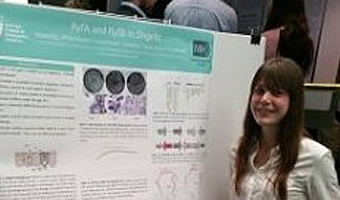Megan E. Fris, a Ph.D. student in Biological Sciences at Ohio University, is the lead author on “Sibling sRNA RyfA1 Influences Shigella dysenteriae Pathogenesis” in the journal Genes.

Megan Fris
The co-authors are William H. Broach, Director of the Ohio University Genomics Facility and an alum who earned a Ph.D. in Biological Sciences in 2014 from the College of Arts & Sciences; Sarah E. Klim ’12, an alum who earned a B.S. in Microbiology from the College of Arts & Sciences; Dr. Peter W. Coschigano, Associate Professor of Biomedical Sciences in the Ohio University Heritage College of Osteopathic Medicine; Dr. Ronan K. Carroll, Assistant Professor of Biological Sciences at Ohio University; Dr. Clayton C. Caswell, Assistant Professor of Bacteriology with the Center for Molecular Medicine and Infectious Diseases, VA-MD College of Veterinary Medicine, Virginia Tech; and Dr. Erin R. Murphy, Assistant Professor of Biomedical Sciences in the Ohio University Heritage College of Osteopathic Medicine.
Abstract: Small regulatory RNAs (sRNAs) of Shigella dysenteriae and other pathogens are vital for the regulation of virulence-associated genes and processes. Here, we characterize RyfA1, one member of a sibling pair of sRNAs produced by S. dysenteriae. Unlike its nearly identical sibling molecule, RyfA2, predicted to be encoded almost exclusively by non-pathogenic species, the presence of a gene encoding RyfA1, or a RyfA1-like molecule, is strongly correlated with virulence in a variety of enteropathogens. In S. dysenteriae, the overproduction of RyfA1 negatively impacts the virulence-associated process of cell-to-cell spread as well as the expression of ompC, a gene encoding a major outer membrane protein important for the pathogenesis of Shigella. Interestingly, the production of RyfA1 is controlled by a second sRNA, here termed RyfB1, the first incidence of one regulatory small RNA controlling another in S. dysenteriae or any Shigella species.



















Comments